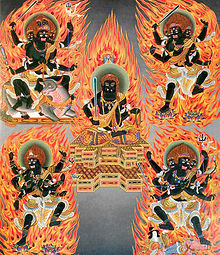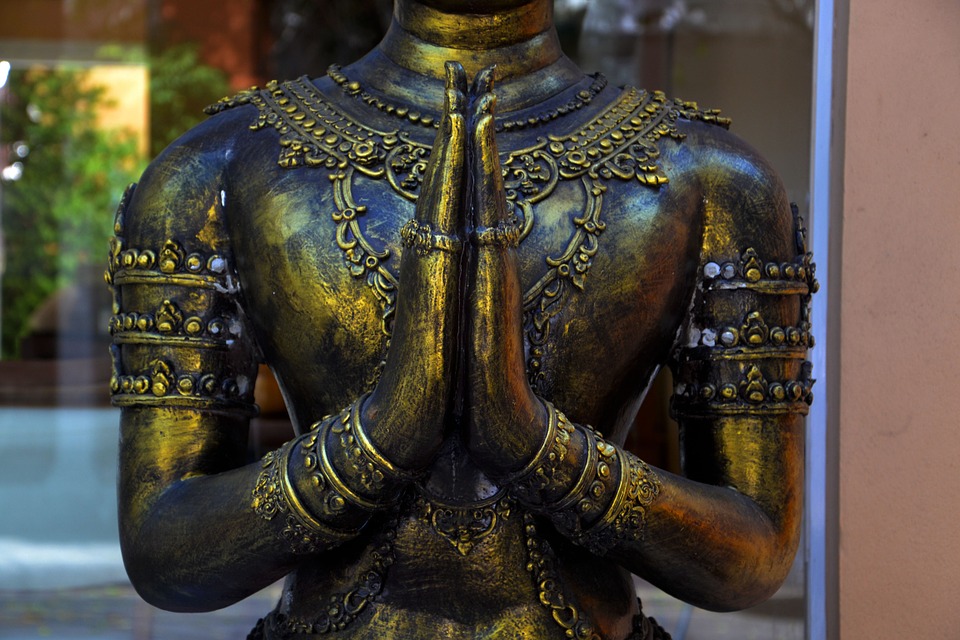The Vidyarajas (Japanese Myo-o) are portrayed in Buddhist teachings as a group of superior beings that help humans lead a better life. They were first given prominence in China by the Shingon sect in about the thirteenth century. From China, the status of the Vidyarajas then spread to Japan, India and other areas. They have figured prominently in Buddhist practice ever since.
Various explanations of the nature of these beings exist in Buddhist learning. Most versions proclaim them to be kings of wisdom and mystical, magical knowledge. Some explanations describe them as god-like and elevate them to the status of true deities.
Human Protection Against Evil
According to ancient Chinese legend, the Vidyarajas have the power to protect humans against evil influences. They are usually portrayed in both writings and artistic imagery as irritated or wrathful beings that protect humans from three great frailties – greed, anger and ignorance by exercising mystical powers or forces (mantras).
There are two groups of Vidyarajas. Perhaps most well-known is the group of five Vidyarajas casts as emanations of the Buddhas of the center plus each of the four cardinal compass directions, namely:
 – The center, Achalanatha (linked with Vairochana).
– The center, Achalanatha (linked with Vairochana).
– The east, Trailokyavijaya (linked with Akshobhya).
– The south, Kundali (linked with Ratnasambhava).
– The west, Yamantaka (linked with Amitabha).
– The north, Vajrayaksha (Vajrapani) (linked with Amoghasiddhi).
Each of these five great Vidyarajas is thought to be a manifestation of one of the five Dhyani Buddhas, also known as Buddhas of meditation Vairochana, Akshobhya, Ratnasambhava, Amitabha and Amoghasiddhi.
The Immutable Lord
Chief among the five Viyarajas is Achalanatha (Chinese Budong Fo, Japanese Fudo-Myo-O), meaning immutable lord. He is believed to be a manifestation of the Dhyani Buddha, Vairochana. He is usually depicted as fierce and angry with brows knitted together and a menacing grimace over his face. His right-hand holds a large sword to combat greed, anger, and ignorance. His left-hand holds a lasso (pasha) to constrain these negative forces and prevent them from doing harm. He is often described as the immovable Buddha to highlight his firmness of spirit and rock-solid immutability.
The 8 Basic Compass Directions.
The second group of Vidyarajas is often referred to as the cult of the Eight Bodhisattvas representing the eight basic compass directions. Recognition of this group first evolved in India during the early development of Mahayana Buddhism. The group was worshipped for protection against suffering from a large range of afflictions including from disease, famine, thirst, and war. The chief of this group of eight Vidyarajas is Ragaraja (Japanese Aizen Myo-o). From India, worship of the group spread to central Asia, in particular, Tibet. One of the earliest texts to describe the worship and imagery surrounding this cult is the Ashtamandalakasutra.
Achalanatha represents the element of spirit or mind – subjective wisdom. Ragaraja represents the five elements of earth, wind, fire, water, and space – objective truth. The pair is often represented as fierce giant warriors carved as large statues guarding the main gates to temples and monasteries.





